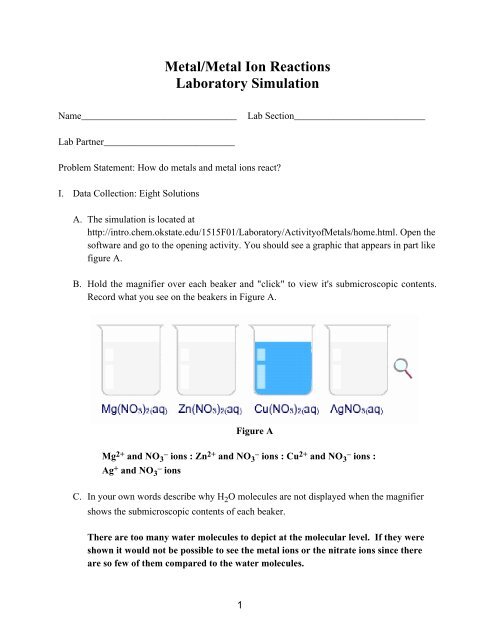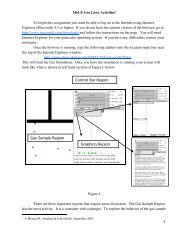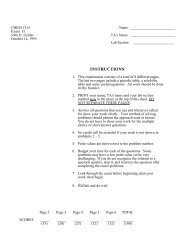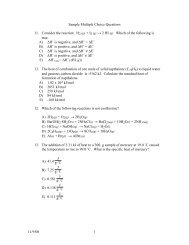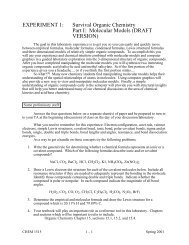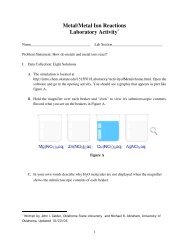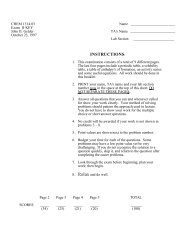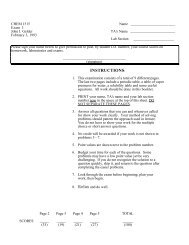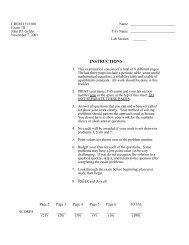Metal/Metal Ion Reactions Laboratory Simulation
Metal/Metal Ion Reactions Laboratory Simulation
Metal/Metal Ion Reactions Laboratory Simulation
- No tags were found...
Create successful ePaper yourself
Turn your PDF publications into a flip-book with our unique Google optimized e-Paper software.
<strong>Metal</strong>/<strong>Metal</strong> <strong>Ion</strong> <strong>Reactions</strong><strong>Laboratory</strong> <strong>Simulation</strong>Name________________________________Lab Section___________________________Lab Partner___________________________Problem Statement: How do metals and metal ions react?I. Data Collection: Eight SolutionsA. The simulation is located athttp://intro.chem.okstate.edu/1515F01/<strong>Laboratory</strong>/Activityof<strong>Metal</strong>s/home.html. Open thesoftware and go to the opening activity. You should see a graphic that appears in part likefigure A.B. Hold the magnifier over each beaker and "click" to view it's submicroscopic contents.Record what you see on the beakers in Figure A.Figure AMg 2+ and NO – 3 ions : Zn 2+ and NO – 3 ions : Cu 2+ and NO – 3 ions :Ag + and NO – 3 ionsC. In your own words describe why H 2 O molecules are not displayed when the magnifiershows the submicroscopic contents of each beaker.There are too many water molecules to depict at the molecular level. If they wereshown it would not be possible to see the metal ions or the nitrate ions since thereare so few of them compared to the water molecules.1
II. Data AnalysisRecord the number of each species in each beaker. How are these numbers related to theformula of the compound?The ratio of the ions in the solution is the same as the ratio of the ions in the formulafor each system.Mg(NO 3 ) 2 : 1 Mg 2+ ion for every 2 NO 3–ions.Zn(NO 3 ) 2 : 1 Zn 2+ ion for every 2 NO 3–ions.Cu(NO 3 ) 2 : 1 Cu 2+ ion for every 2 NO 3–ions.AgNO 3 : 1 Ag + ion for every 1 NO 3–ions.III. InterpretationA. List three characteristics that are the same for all of these solutions and threecharacteristics that make them different.All four solutions contain metal ions and nitrate anions, the compounds that aredissolved are ionic compounds, all have the same volume of solution.For three of the solution the cation is divalent, while one of the cations ismonovalent, one of the solutions has a different color, two of the cations are in the4 th period, one from the 3 rd period and one from the 5 th period.B. Identify the species that accounts for the color of each of the four solutions. Whatevidence did you use to arrive at your conclusions?Since all of the solutions contain water and the same anion, the color can not be dueto the anion. The metal ions are different, so the color must be due to the differentcations.2
C. Predict and record in Figure B what you would expect to see with the magnifier in theother beakers.Figure BThe ratio of the ions in the solution is the same as the ratio of the ions in the formulafor each system.Fe(NO 3 ) 2 : 1 Fe 2+ ion for every 2 NO – 3 ions.Pb(NO 3 ) 2 : 1 Pb 2+ ion for every 2 NO – 3 ions.Ni(NO 3 ) 2 : 1 Ni 2+ ion for every 2 NO – 3 ions.Sn(NO 3 ) 2 : 1 Sn 2+ ion for every 2 NO – 3 ions.3
IV. Data Collection: Activity OneA. Go to Activity One in the simulation, pick one of the metals and follow the instructions totest its interaction with each of the solutions. Record your observations in Table 1 below.Describe any evidence you see for a chemical reaction. What changes do you see in themetal? What changes do you see in the solutions?B. Repeat this process with each of the metals.Mg 2+ Cu 2+ Zn 2+ Ag +MgNo reactionSolid plates out onthe magnesium stripand the intensity ofthe blue color in thesolution is reducedin intensitySolid plates out onthe magnesiumstrip, no colorchange in thesolution.Solid plates out onthe magnesiumstrip, no colorchange in thesolution.Cu No reaction No reaction No reactionSolid plates out onthe copper strip andthe solution’s colorchanges fromcolorless to greenishblue.ZnNo reactionSolid plates out onthe zinc strip andthe intensity of thecolor in the solutionis reduced after thestrip is removedNo reactionSolid plates out onthe zinc strip, nocolor change in thesolution.Ag No reaction No reaction No reaction No reactionTable 14
InterpretationA. How are Tables 2a and 2b in the previous section related to each other? Write a balancedequation relating each metal ion to its corresponding metal.The reactivity of the metals is exactly opposite the reactivity of the correspondingcation. While solid magnesium was the most reactive metal, its ion, Mg 2+ , was the leastreactive.Mg 2+ + 2e – → MgZn 2+ + 2e – → ZnCu 2+ + 2e – → CuAg + + 1e – → AgB. Pick one of the metals in Table 2b. Using the reactivity data you collected (Table 1),mark the metal ions in Table 2a that chemically reacted with it. Note the position of thesereacting ions in relation with the position of those that don't react. Repeat this process foreach of the metals. Summarize your findings concerning the combination of reactingmetals and metal ions in Tables 2a and 2b.Any particular metal in Table 2b reacts with the metal ion in Table 2a that is tothe left and above itself. For example, Mg metal will react with Zn 2+ (aq), Cu 2+ (aq),and Ag + (aq).Summarize your findings concerning the combination of non-reacting metals and metalions in Tables 2a and 2b.Any particular metal in Table 2b wll not react with the metal ion in Table 2athat is to the left and below itself. For example, Ag metal will not react with Cu 2+ (aq),Zn 2+ (aq), or Mg 2+ (aq).C. "Click" on the molecular scale button in the laboratory simulation to view themetal/metal ion interactions at the submicroscopic level. Follow the instructions in thesoftware. Describe your observations of reacting combinations and non-reactingcombinations. Write a chemical equation for one of the reacting combinations. Relateyour submicroscopic observation with your macroscopic observations for one example ofa reacting and one example of a non-reacting combination.For a reacting combination such as Mg(s) and Cu 2+ (aq) the molecular levelanimation showed the Cu 2+ (aq) ions approaching the Mg strip. When the ions werealmost in contact with the metal strip electron appeared in tn the metal movingtowards the Cu 2+ (aq) ions. The Cu 2+ (aq) ions gained the electrons and formedCu(s), while the Mg(s) lost the electrons forming Mg 2+ (aq) ions.Mg(s) + Cu 2+ (aq) → Cu(s) + Mg 2+ (aq)At the macroscopic level for the above reaction we saw a brownish-red material thatmust be Cu(s) plated on the magnesium strip. Since copper metal had plated out6
there were fewer Cu 2+ (aq) in solution and the intensity of the solution’s colordecreased.In the nonreacting combination such as Cu(s) and Zn 2+ (aq) the zinc ionsapproached the copper strip but no reaction occurred. At the macroscopic levelnothing plated out on the copper strip immersed in the Zn 2+ (aq) solution, nor wasthere any color change in the solution.7
VII.Data Collection: Activity TwoGo to Activity Two and repeat what you did in sections IV, V, and VI with a new set ofmetal/metal ions.Fe 2+ Pb 2+ Ni 2+ Sn 2+FeNo reactionSolid plates out onthe iron strip andthe color in thesolution changesfrom colorless to agreenish color.Solid plates out onthe iron strip andthe color in thesolution changesslightly, although itis difficult to tell.Solid plates out onthe iron strip andthe color in thesolution changesfrom colorless to agreenish color.Pb No reaction No reaction No reaction No reactionNiNo reactionSolid plates out onthe nickel strip andthe color in thesolution changesfrom colorless to agreenish color.No reactionSolid plates out onthe nickel strip andthe color in thesolution changesfrom colorless to agreenish color.SnNo reactionSolid plates out onthe tin strip No reaction No reactionTable 38
VIII.Data Analysis and InterpretationD. Write chemical equations for the chemical reactions you observed.Fe(s) + Pb(NO 3 ) 2 (aq) → Pb(s) + Fe(NO 3 ) 2 (aq)Fe(s) + Ni(NO 3 ) 2 (aq) → Ni(s) + Fe(NO 3 ) 2 (aq)Fe(s) + Sn(NO 3 ) 2 (aq) → Sn(s) + Fe(NO 3 ) 2 (aq)Ni(s) + Pb(NO 3 ) 2 (aq) → Pb(s) + Ni(NO 3 ) 2 (aq)Ni(s) + Sn(NO 3 ) 2 (aq) → Sn(s) +Ni(NO 3 ) 2 (aq)Sns) + Pb(NO 3 ) 2 (aq) → Pb(s) + Sn(NO 3 ) 2 (aq)E. Rank the metal ions and metals as you did in section V.B. Write balanced equationsrelating the metal ion/metal combinations.<strong>Metal</strong> <strong>Ion</strong> Table<strong>Metal</strong> TablePb 2+PbMostSn 2+SnMostReactiveNi 2+NiReactiveFe 2+FeTable 4aTable 4b9
X. Data Analysis and ConclusionsUse the data you collected in Activities One, Two, and Three (Tables 1,3 and 5) to rank theeight metal ion and metals you have studied. Write balanced equations relating themetal/metal ion combinations.<strong>Metal</strong> <strong>Ion</strong> TableAg +<strong>Metal</strong> TableAgMostReactiveCu 2+Pb 2+CuPbSn 2+SnNi 2+NiFe 2+Zn 2+FeZnMostReactiveMg 2+MgTable 6aTable 6bXI. Data Collection – Activity FourGo to Activity Four and follow the directions. Record your observation concerning thereaction of the five metals with HCl.Ni(s), Sn(s) and Pb(s) all react with the HCl, but Cu(s) and Ag(s) do not.Reaction was evident from the formation of bubbles of a gas. Neither Cu(s) orAg(s) produced in bubbles of gas.11
XII. Data AnalysisA. Write a chemical equation for the reaction between one of the metals and HCl.Ni(s) + 2HCl(aq) → H 2 (g) + NiCl 2 (aq)B. Observe the reaction at the molecular scale. Write an equation for what is happening tothe metal and a separate equation for what is happening to the acid. How are theseequations related to each other and to the chemical equation you wrote in section XII.A.For the metal: Ni(s) → Ni 2+ (aq) + 2e –For the acid: 2H + (aq) + 2e – → H 2 (g)Adding the two equations together produces the overall equation in XIIA. Theelectrons produces from the Ni(s) are picked up by the H + ions to form H 2 (g).XIII.Interpretation and ConclusionsA. Add the hydrogen gas /hydrogen ion combination in the correct location in the tablesfrom section X.<strong>Metal</strong> <strong>Ion</strong> Table<strong>Metal</strong> TableAg +AgMostReactiveCu 2+CuH + H 2Pb 2+PbSn 2+SnNi 2+Fe 2+Zn 2+NiFeZnMostReactiveMg 2+MgTable 7aTable 7b12
B. Use the information in Tables 7a and 7b to predict the products of the followingreactions.Ag + (aq) + Ni (s) → Ag(s) + Ni 2+ (s)Ni 2+ (aq) + Ag (s) → no reactionAg + (aq) + Sn (s) →Ag (s) + Sn 2+ (aq)Mg 2+ (aq) + Ni (s) → no reactionMg (s) + Sn(NO 3 ) 2 (aq) → Sn(s) + Mg(NO 3 ) 2 (aq)H + (aq) + Mg (s) → H 2 (g) + MgCl 2 (aq)HCl (aq) + Sn (s) → H 2 (g) + SnCl 2 (aq)Fe 2+ (aq) + H 2 (g) → no reactionAg + (aq) + Mg 2+ (aq) → no reactionH 2 (g) + Cu 2+ (aq) → Cu(s) + 2H + (aq)F. Mental Model: Draw a picture(s) that illustrates what happens at the molecular levelwhen Ag + ion and Sn metal are mixed. In words explain what is happening in yourpicture(s).G. An unknown metal, M, is found to react with Ag + ion, Pb 2+ ion and Cu 2+ ion, but not withNi 2+ ion, Mg 2+ ion or Zn 2+ ion. Where does the unknown metal, M, appear in your activityseries?13
The unknown metal has to appear between Pb(s) and Ni(s). There is not enoughinformation to determine if the unknown metal is more reactive than Sn or lessreactive.14


